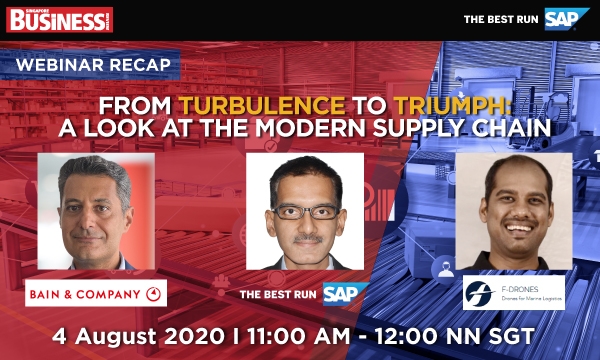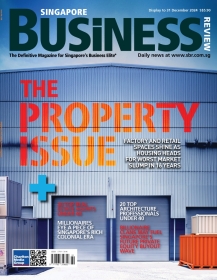
Why digital supply chains have become vital considerations in 2020
Supply chain digitalisation and modernisation were the key focus areas in the From Turbulence to Triumph webinar, recorded on August 4.
“I don’t think there is any boardroom in the world not discussing supply chain resilience (right now).” So opined Gerry Mattios, expert partner with Bain & Company, in his opening address to the From Turbulence to Triumph: A Look at the Modern Supply Chain webinar, hosted by Singapore Business Review in partnership with SAP on August 4.
It is not just the Covid-19 pandemic demanding this new focus of business leaders, though Mattios says that has certainly caught companies by surprise and accelerated the trend. Technology changes, global trade wars, and e-commerce have also each played a role and kept the supply chain “top of mind”
Mattios broke down the reactions of many businesses, from the immediate actions of the “Act Now” phase, to the “Plan Now” phase to a retooling of supply chains for the “New Normal” of post-COVID-19 business.
His most-pro-active clients are using tools such as predictive analytics to ensure supply chains can analyse risks and react to market changes.
Aviation-grade drones to the rescue
One supply chain innovation now impacting the marine and shipping industries in particular is the use of unmanned aerial vehicles, or drones, to complete last-mile deliveries with greater efficiency, safety, and speed.
Yeshwanth Reddy, founder of the Singapore-based startup F-drones, is playing a key role in this trend. His presentation focused on the expanding use of these devices in Singapore’s marine industry.
While currently, regulations limit the payload that drones can deliver over Singapore waters to 5kg only, Reddy is confident a significant expansion is on the cards – his aviation-grade drones can carry loads of up to 100kg (for trips of up to 100km).
But even despite these restrictions, Reddy is finding plenty of demand for drone-delivery services to ships anchored off shore in Singapore. Some of the more curious items to have taken the trip across the water include a Playstation console (for a crew member’s birthday) and undisclosed amounts of cash and currency.
“We are the first company to do drone deliveries to shops anchored outside Singapore,” Reddy said. “We are solving the maritime last-mile delivery problem.
“Every year, 2.5 million trips are made using small boats and helicopters to deliver common items to ships that are anchored away from the shore, and offshore platforms. They are quite expensive to deliver these items, it’s quite time consuming, and (the trips) have an enormous carbon footprint.”
Customers leading the way
Sreekumar Sivaramakrishnan, senior director for the Transportation and Logistics Industries with SAP Southeast Asia, took a customer-centric perspective with his presentation to the From Turbulence to Triumph webinar.
He noted that “doorstep deliveries” have become a key customer demand across both consumer and business-to-business supply chains. So-called touchless supply chains have also surged in demand with the current pandemic environment.
“The concept of ‘touchless’ has existed for a few years; but the current pandemic has accelerated the need for each one of you (supply chain professionals) to think outside the box,” he said. “It has become the necessity, rather than the priority.”
“The bottom line is the faster you automate the interaction points between you and your end customer in a very safe environment, only then will you stay afloat in this highly customer-centric environment.”
Technology and software solutions can be the big difference here, and Sivaramakrishnan says the right tools can help organisations to “predict”, “automate”, and “analyse” their supply chain performance.
With the machine learnings and artificial intelligence of today, businesses can leverage technology for more accurate predictions, closer analysis, and more efficient supply chains, he said.
























 Advertise
Advertise






